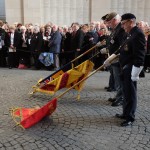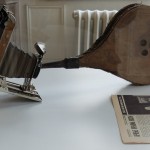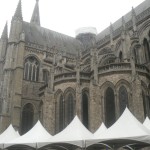In May 2015, WCT Members visited Ypres in Belgium to see for themselves the battle fields of the First World War and attend a spectacular outdoor performance of Furious Folly, in Poperinge, Belgium.
In Furious Folly, Mark Anderson leads a team of artists that, in the spirit of the Dadaists, attempt to respond to the inconceivable madness of the First World War.
Taking place, as night falls, in the no-mans land between the two sides, the audience are immersed within an open-air collage of sound, kinetic devices, pyrotechnics and performance.
Anderson draws on the anti-war sentiment of the Dadaist movement of the early 20 century. The madness of the battlefield and the futility of the Great War as a whole, led these artists to answer with a new artistic language, one that deliberately eschewed structure and meaning rejecting everything that had gone before. Furious Folly uses the Dada ethos to shape a powerful work that rails against the inhumanity and senselessness of conflict past and present.
The show was produced by Simon Chatterton, co-artistic director of Dorset’s Inside Out Festival. Claire Raftery from Periplum who worked with WCT in 2014, was the Performance Director.
WCT Members also visited the excellent Museum In Flanders Fields in Ypres where stories of extraordinary and ordinary people are displayed interactively, as well as several War Graves in the vicinity, and attended the moving daily ceremony held at the Menin Gate.

The Last Post, the traditional final salute to the fallen, is played by the buglers in honour of the memory of the soldiers of the former British Empire and its allies, who died in the Ypres Salient during the First World War. It is organised by the Last Post Association which intends to maintain this daily act of homage in perpetuity.

The Smell of War exhibition in the Castle de Lovie and curated by Peter de Cupere, included work by international artists reflecting on the impact of the first gas attacks in World War 1, through the sense of smell. This Odorgraph was made in 1914 by a previously unknown artist, Caflo Yrot (Ukraine).
For more information, about Olfactory Art see here

